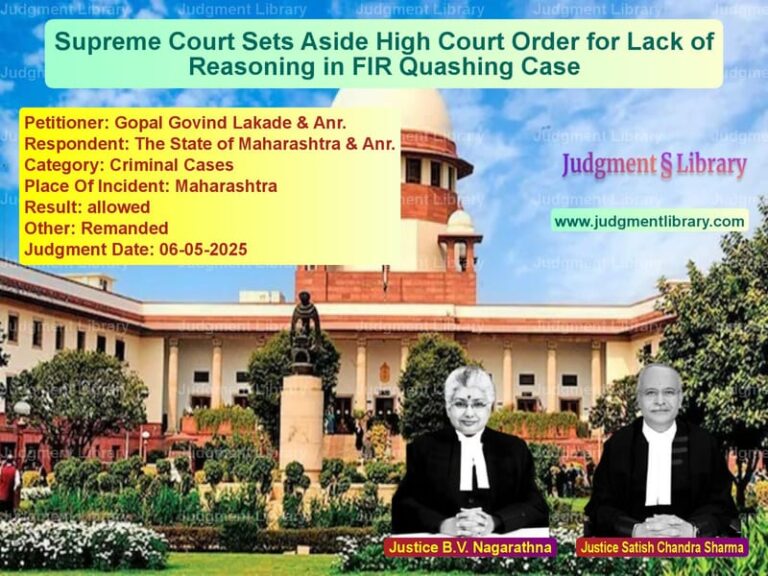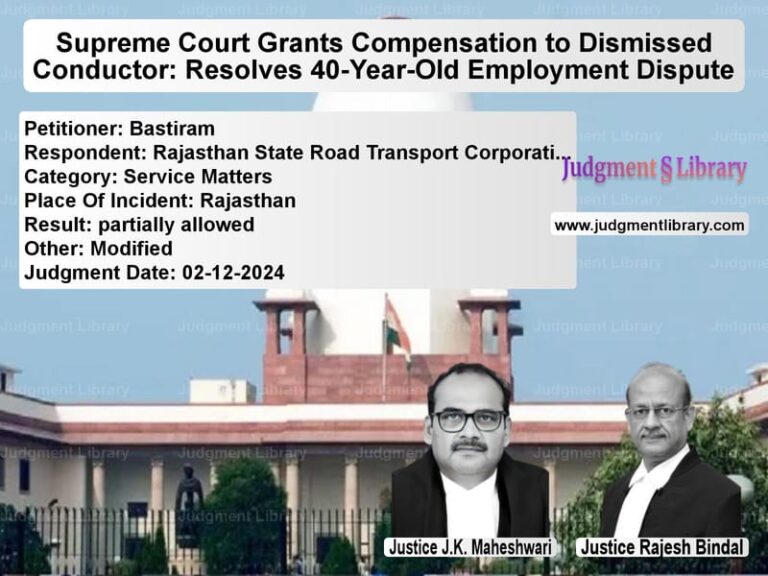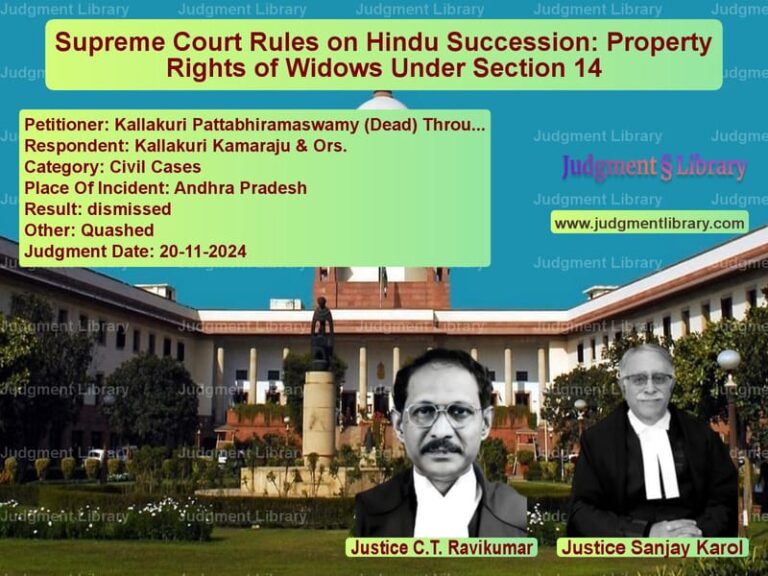Supreme Court Rejects Appeal in Goa Forest Land Case: Finality to Private Forest Identification
The Supreme Court of India has delivered a landmark ruling in In Re: T.N. Godavarman Thirumulpad vs. Union of India & Ors., solidifying the identification criteria for private forests in the state of Goa. The ruling rejected an appeal seeking to modify these criteria, thereby reaffirming the long-standing principles of environmental governance and the role of expert committees in defining forest land.
Background of the Case
The dispute over the identification of private forests in Goa has been ongoing for decades. The case was originally filed as Writ Petition (Civil) No. 202 of 1995 by environmentalist T.N. Godavarman Thirumulpad. Over time, it evolved into a major environmental litigation with implications for forest conservation across India.
The primary contention in the present appeal, filed by the Goa Foundation, was that the criteria for identifying private forests should be revised to align with the definitions used by the Forest Survey of India (FSI). The petitioner argued that instead of using the existing 40% canopy density and 5-hectare area requirement, the definition should be modified to include land with a minimum of 10% canopy density and an area of at least 1 hectare.
Key Legal Issues
The case revolved around the following legal questions:
- Whether the identification criteria for private forests in Goa, established in 1991, should be modified.
- Whether the Supreme Court’s previous rulings in the Tata Housing Development Corporation case and Nisarga vs. Asst. Conservator of Forests precluded further modification of these criteria.
- Whether the 2015 interim order that halted development on lands with tree canopy density exceeding 10% should be vacated.
Petitioner’s Arguments
The appellant, Goa Foundation, argued:
- The existing identification criteria were outdated and did not reflect modern definitions of forests.
- The Supreme Court had accepted the FSI’s classification of forest lands in prior cases concerning Net Present Value (NPV) assessments.
- The State of Goa’s criteria, requiring 40% canopy density and a minimum of 5 hectares, excluded many ecologically significant lands.
- Failure to modify the criteria would allow deforestation and unauthorized land conversion.
Respondents’ Arguments
The State of Goa and other respondents, including the Confederation of Real Estate Developers’ Associations of India (CREDAI), countered:
- The existing criteria had already been validated by multiple expert committees.
- The appellant had previously raised similar arguments in Tata Housing and Nisarga, and the courts had rejected them.
- Reducing the criteria to 10% canopy density and 1 hectare would lead to unintended consequences, including classifying small tree clusters on private land as forests.
- Most states in India use varying criteria suited to their geographical and ecological conditions, and Goa’s criteria were well within reasonable limits.
Supreme Court’s Key Observations
The Supreme Court analyzed the legal history of forest conservation cases and concluded:
“The process of physical demarcation of such forests in the State of Goa seems to have attained finality by virtue of the reports submitted by expert committees. It is neither feasible nor desirable to reopen this issue after decades of litigation.”
“If the petitioner’s argument were accepted, it would require classifying vast swaths of privately owned land with scattered trees as forests, leading to legal uncertainty and unnecessary hardship for landowners.”
“It is necessary to allow individual states to develop forest identification criteria suitable for their unique environmental conditions, rather than imposing a one-size-fits-all approach.”
Final Judgment
The Supreme Court ruled:
- The existing private forest identification criteria in Goa (40% canopy density and 5 hectares minimum area) are valid and final.
- The appeals seeking modification of these criteria are dismissed.
- The interim order dated February 4, 2015, which restricted development on lands with a canopy density above 10%, is vacated.
- The government may proceed with its existing identification and demarcation process without further modifications.
Implications of the Judgment
The ruling has significant ramifications for environmental governance and property rights:
- Clarity on Forest Identification: The decision reaffirms the long-standing criteria for private forests, bringing stability to environmental regulations in Goa.
- Precedent for Other States: The ruling sets a benchmark for other states, emphasizing the importance of localized forest identification criteria.
- Development vs. Conservation Balance: The judgment ensures that environmental protection is maintained without placing undue restrictions on legitimate land use.
Conclusion
The Supreme Court’s judgment in In Re: T.N. Godavarman Thirumulpad vs. Union of India reaffirms the principle that expert-driven criteria should guide environmental regulations. By upholding the Goa government’s forest identification process, the ruling strikes a balance between ecological conservation and pragmatic governance. This decision marks the end of decades-long litigation on the issue and provides legal certainty for landowners and conservation authorities alike.
Petitioner Name: T.N. Godavarman Thirumulpad.Respondent Name: Union of India & Ors..Judgment By: Justice B.R. Gavai, Justice Aravind Kumar, Justice Prashant Kumar Mishra.Place Of Incident: Goa.Judgment Date: 24-01-2024.
Don’t miss out on the full details! Download the complete judgment in PDF format below and gain valuable insights instantly!
Download Judgment: t.n.-godavarman-thir-vs-union-of-india-&-ors-supreme-court-of-india-judgment-dated-24-01-2024.pdf
Directly Download Judgment: Directly download this Judgment
See all petitions in Environmental Cases
See all petitions in Public Interest Litigation
See all petitions in Judgment by B R Gavai
See all petitions in Judgment by Aravind Kumar
See all petitions in Judgment by Prashant Kumar Mishra
See all petitions in dismissed
See all petitions in Stayed
See all petitions in supreme court of India judgments January 2024
See all petitions in 2024 judgments
See all posts in Environmental Cases Category
See all allowed petitions in Environmental Cases Category
See all Dismissed petitions in Environmental Cases Category
See all partially allowed petitions in Environmental Cases Category







